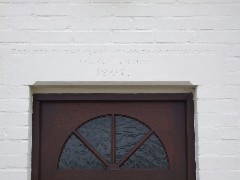| Rather curiously, the 1851
census of Religious Worship saw two
entries submitted for this chapel. One
came from William Howie Bull, the snooty
new vicar of the nearby Anglican Parish
Church, and there was another sent in,
more correctly, on behalf of Mr Phillips,
the Primitive Methodist Minister at
Stowmarket, of which this was an
outstation. Quite
what the Reverend Bull thought he was
doing submitting a return for the chapel
I don't know: perhaps he misunderstood
the rules, but this was the only case, in
Suffolk at least, of a Minister
submitting a return for a church which
was not his. Perhaps it was to get in his
defence in first: he wrote of his own
church that it was quite full every
Sunday afternoon without variation of
consequence. But Mr Phillips showed
that the chapel could hold its head up
too: the 120 at the chapel afternoon
service was barely a quarter of the
extraordinary 400-odd at the parish
church, but the combined attendance, out
of a population of less than 800, meant
that the percentage of residents
attending church in Old Newton was
probably the highest of any parish in all
of Suffolk, where a figure of between a
quarter and a third was more common.
Methodist chapels are, of
course, gathered congregations, so people
may have travelled in from elsewhere. But
the percentage of the parish population
attending the Anglican church is
extraordinary - more than half! This was
not to be found anywhere else in Suffolk
- if the Reverend Bull was telling the
truth, of course.
|
|
 |

